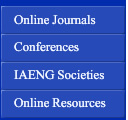

 |
 |
 |
 |
|
Engineering Letters Engineering Letters is published with both online and print versions. The journal covers the frontier issues in the engineering and computer scienceand their applications in business, industry and other subjects. The subjects covered by the journal include artificial intelligence, bioinformatics, computational statistics, database, data mining, financial engineering, hardware systems, imaging engineering, industrial engineering, internet computing, networking, operations research, scientific computing, software engineering, and their applications etc. ISSN: 1816-0948 (online version); 1816-093X (print version) Editorial Board Members Editorial Board Members
Tsakalidis Athanasios Prof. Tsakalidis Athanasios, born in 1950, obtained his Diploma in Mathematics from the University of Thessaloniki, Greece, in 1973, his Diploma in Computer Science (1981) and his Ph.D. (1983) from the University of Saarland, Saarbuecken, Germany (in computer science; advisor: Prof. K. Mehlhorn, who was the director of MAX PLANCK INSTITUTE of INFORMATICS in Germany). He is currently the R&D-Coordinator of the Computer Technology Institute (CTI, Patras-Greece) and a Full Professor in the Department of Computer Engineering and Informatics, University of Partas, Greece. Since 1995, he has been the head of the Laboratory of Graphics, Multimedia and GIS of the Department of Computer Engineering and Informatics. Starting from 2002, he is also a visiting professor of the King College, University of London. His research interests include Data Structures, Graph Algorithms, Computational Geometry, Expert Systems, GIS, Medical Informatics, Databases, Multimedia, Information Retrieval, and Bioinformatics. Prof. Tsakalidis Athanasios has been one of the co-authors to one of the most significant books of Computer Science, titled "Handbook of Theoretical Computer Science", published by Elsevier Science Publishers and MIT-Press. During the last years he has been evolved in several research projects under the framework of the EC programmes: ESPRIT, RACE, AIM, STRIDE, Basic Research Actions in ESPRIT, ESPRIT special Actions, Telematics Applications, ADAPT, HORIZON, INTERREG II, as well as projects funded by the General Secretariat For Research & Technology, Ministry of Development. He is the author of four books: Computational Geometry, Data Structures, Advanced Data Structures and Computer-Graphics and e-Commerce. He has published about 50 referred research articles in international journals and more than 160 referred papers in international conferences. He has been the thesis supervisor of more than 200 students.
Dr Jari Kaivo-oja has worked for the University of Helsinki, Tampere University of Technology and University of Tampere. In the field of international foresight research he has done work for the European Commission (Terra2000, co-ordinator RAND Europe, Leiden, the Netherlands), the European Foundation (EUFORIA, co-ordinator PREST, Manchester, UK), Eurostat (Ecostat, co-ordinator Pantheon University, Athens, Greece) and Nordic Innovations Center (NIC, co-ordinator RISOE, Roskilde) as a researcher and research co-ordinator. Dr Kaivo-oja is an expert member of Finnish National Futures Sparring Forum, European COST Activity A22 Network (Foresight methodologies), Nordic Foresight Network (Nordic Innovation Area), and European Sustainability Strategy Network. At the FFRC he is a research director responsible for foresight research field and team management. Dr Kaivo-oja is full member of the Association of Professional Futurists (APF). He is author or co-author of 22 books and 65 refereed articles on topics such as foresight tools, futures thinking studies, knowledge society development, innovation management, integrated knowledge management of foresight research, sustainability analysis and evaluation methods, global energy markets and environmental management systems. Recently in 2005 he has been working with the following foresight projects: - The Long Run Infrastructures in Finland/Ministry of Environment;
Majid Sarrafzadeh received his B.S., M.S. and Ph.D. in 1982, 1984, and 1987 respectively from the University of Illinois at Urbana-Champaign in Electrical and Computer Engineering. He joined Northwestern University as an Assistant Professor in 1987. In 2000, he joined the Computer Science Department at University of California at Los Angeles (UCLA). His recent research interests lie in the area of Embedded and Reconfigurable Computing, VLSI CAD, and design and analysis of algorithms. He is a Fellow of IEEE for his contribution to "Theory and Practice of VLSI Design". He received an NSF Engineering Initiation award, two distinguished paper awards in ICCAD, and the best paper award in DAC. He has served on the technical program committee of numerous conferences in the area of VLSI Design and CAD, including ICCAD, DAC, EDAC, ISPD, FPGA, and DesignCon. He has served as committee chairs of a number of these conferences. He is on the executive committee/steering committee of several conferences such as ICCAD, ISPD, and ISQED. Professor Sarrafzadeh has published approximately 250 papers, is a co-editor of the book "Algorithmic Aspects of VLSI Layout" (1994 by World Scientific), and co-author of the books "An Introduction to VLSI Physical Design" (1996 by McGraw Hill) and "Modern Placement Techniques" (2003, Kluwer). He is also on the editorial board of the VLSI Design Journal, an Associate Editor of ACM Transaction on Design Automation (TODAES) and an Associate Editor of IEEE Transactions on Computer-Aided Design (TCAD). Professor Sarrafzadeh has collaborated with many industries in the past fifteen years including IBM and Motorola and many CAD industries and was the architect of the physical design subsystem of Monterey Design Systems' main product. He is a co-founder of Hier Design, Inc, and he is the director of the Embedded & Reconfigurable Systems Lab of UCLA Computer Science Department.
Prof. Hamid R. Arabnia received a Ph.D. degree in Computer Science from the University of Kent (Canterbury, England) in 1987. In 1987, he worked as a Consultant for Caplin Cybernetics Corporation (London, England), where he helped in the design of a number of image processing algorithms that were targeted at a transputer-based machine architecture. Prof. Arabnia is currently a faculty of Computer Science at University of Georgia (Georgia, USA), where he has been since 1987. His research interests include parallel algorithms, reconfigurable machines, interconnection networks, and applications of parallel processing in remote sensing and medical imaging. Prof. Arabnia has chaired many national and international conferences and technical sessions in these areas. He is Editor-in-Chief of The Journal of Supercomputing (Springer) and is on the editorial boards of 11 other journals. Prof. Arabnia is Chair of World Committees of PDPTA (parallel and distributed processing techniques and applications), CISST (imaging science, systems, and technology), SAM (security and management), ICAI (artificial intelligence), and other affiliated research organizations. He is Director/Chair of World Academy of Science (2004 - 2009). Prof. Arabnia is the recipient of William F. Rockwell, Jr. Medal for promotion of multi-disciplinary research (Rockwell Medal is International Technology Institute's highest honor). In 2000, Prof. Arabnia was indicted to the World Level of the Hall of Fame for Engineering, Science and Technology (The World Level is the highest possible level for a living person íV there are two higher levels which are posthumous.) Prof. Arabnia has published extensively in journals and refereed conference proceedings; he has over 250 research publications.
Prof. Hugo de Garis has been the Economist Magazine's "World Technology Award" Finalist (1999). In 2000, he obtained US$1 million grant from Brussels Government to build an Artificial Brain, and, in 2001, his artificial brain was recorded in the Guinness Book of World Records "Most Complex Brain Building Machine" (p126, 2001). He obtained a B.Sc. (Hons) in Applied Mathematics and Theoretical Physics at Melbourne University, Victoria, Australia, in 1970. He moved to the UK where he was a supervisor (instructor) to the mathematics undergraduates of Cambridge University for 4 years. He then joined Philips in Holland and Belgium as a software and hardware architect, covering most branches of computer science. Growing discontent with industry, he switched careers to do research at Brussels University, where he finished a PhD in Artificial Intelligence and Artificial Life. Prof. Dr. de Garis has published some 70 journal/conference papers and book chapters. From February 1993 to January 2000, de Garis was the head of the Brain Builder Group in the Evolutionary Systems Department at ATR Labs in Kyoto, Japan. The aim was to use Cellular Automata Machines (CAMs) to grow/evolve a 75 million neuron (64K module) artificial brain at electronic speeds, using state of the art evolvable hardware (Xilinx XC6264 FPGA chips) which can update CA cells at over 130 Billion a second, and evolve neural network modules in about a second. The name of this research effort was the "CAM-Brain Project". It is de Garis's ambition to see the building of artificial brains grow into a major effort equivalent to America's NASA moon shot. From Sept 2001, Dr. de Garis has been an associate professor of computer science at Utah State University (USU), Logan, Utah, USA, teaching the planet's first (M.Sc./PhD) course in "Brain Building", and another new course, "Frontiers of Computing" (quantum computing, reversible computing, nanotechnology, DNA computing, membrane computing, quantum dots, molecular computing, etc). He aims to build a new generation of brain building machine and an artificial brain, each 5 years or so. He is currently looking for funding towards these goals. Prof. de Garis is setting up a "Brain Building Center" at USU, consisting of researchers, students, professors, and commercial interests (May 2002, 11 people so far).
Prof. Graham Megson is the former Acting Vice Chancellor and Provost, University of Westminster. He has been the Professor of Computer Science at the University of Reading from 1995 to 2008. He was Head of Department from 1997-98, and Head of Parallel Emergent and Distributed Architectures Laboratory (PEDAL) at Reading and has enjoyed significant funding from Newcastle University. From 1990-1995 he co-ordinated the University funded Strategic Research Initiative on Parallel Algorithms Research, Newcastle University. From 1995 - present has been the director of the High Performance Computing Centre (HPCC, a facility of over UKP 1M), at the University of Reading. His work has led to numerous innovative systolic algorithms and the development of the first systematic synthesis method for mapping classes of dynamic (or run-time) dependencies onto regular arrays. Synthesis Tools have been incorporated into the public domain version of MMAlpha. He has solved a number of open mapping problems in the areas of dynamic programming and combinatorial optimization, and in connection with Honeycomb tori as well as designing numerous application specific algorithms. His current interests centre on the development of systematic methods for mapping and scheduling computations on to parallel architectures encompassing the analysis and design of regular parallel algorithms, massively parallel, Field Programmable Gate Arrays, as well as Neural Networks and Genetic Algorithms. Professor G.M. Megson (BSc(Hons), PhD, CEng, MBCS) was awarded
a BSc(Hons) Class I in computational science from Leeds University
in 1984. After a period of postgraduate research, at Loughborough
University, in 1987 he recieved a PhD for work in systolic algorithm
design. In July 1987 he was appointed as the ATLAS Research Fellow
at Rutherford Appleton Laboratory (RAL) and simultaneously held
a Junior Fellowship of Oriel College, Oxford University. Prof. Graham
Megson is a member of the BCS, has served on over 10 Programme Committees
for international conferences. He has been a member of the IEEE
technical committee on computer architecture, the EPSRC review college
for the system architectures committee, and currently served on
the AWE Supercomputing Panel. He is editor-in-chief of the Journal
Parallel Algorithms and Applications (1997-), and edits an international
book series on parallel computing. He has published over 130 papers
at international conferences in journals including five books on
systolic algorithms/architectures and related topics. Editors Editorial Board Members
|
Engineering Letters Join IAENG Now!
IAENG Official Web Sites: IAENG COM (www.iaeng.com)
|

|
International Association of Engineers © Copyright International Association of Engineers |






